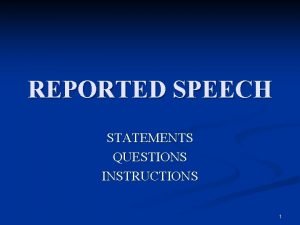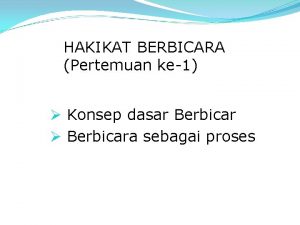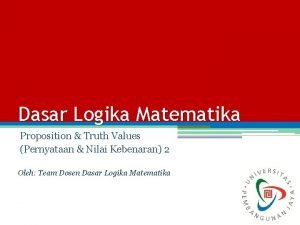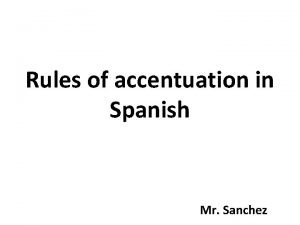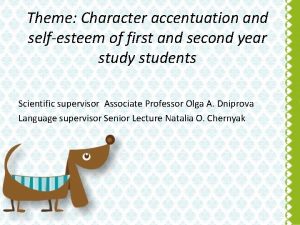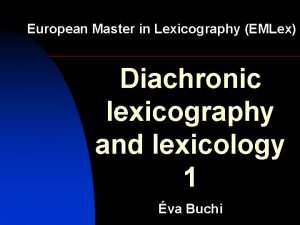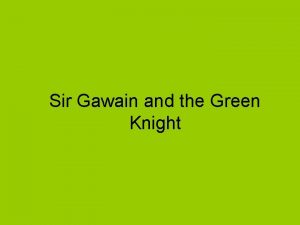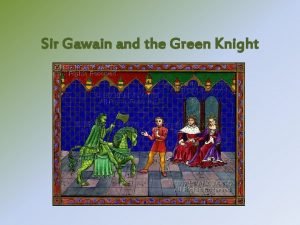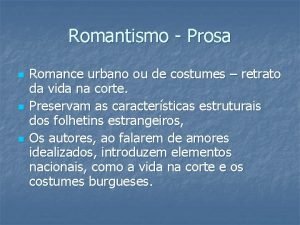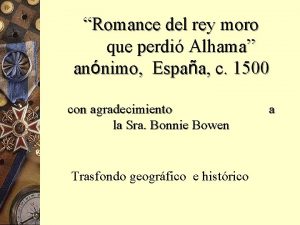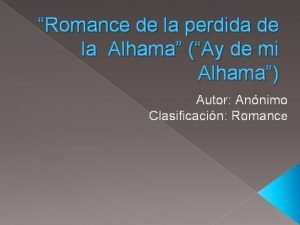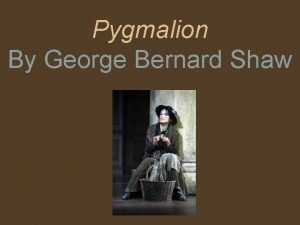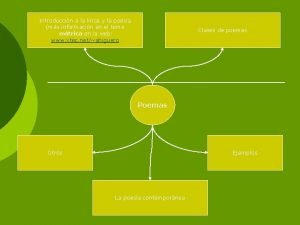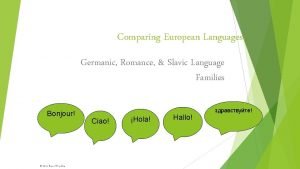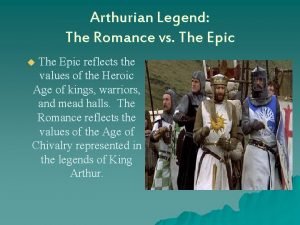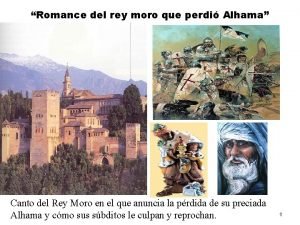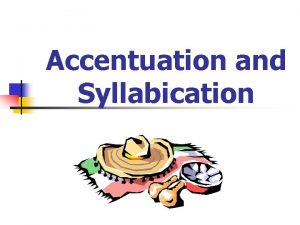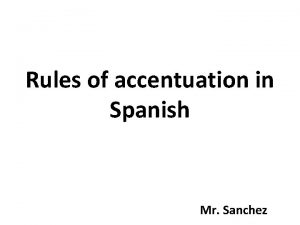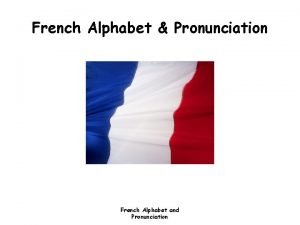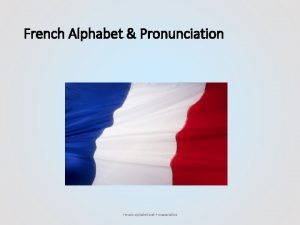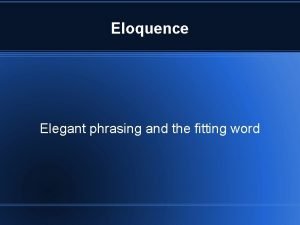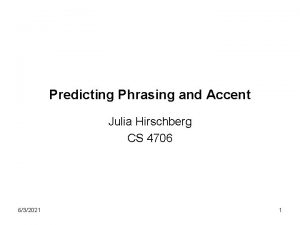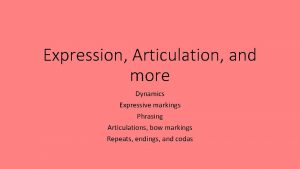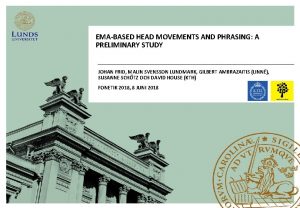Accentuation and phrasing in Romance Occitan and French









































- Slides: 41

Accentuation and phrasing in Romance: Occitan and French Rafèu Sichel‐Bazin 1, 2, Carolin Buthke 1, Trudel Meisenburg 1 1 Universität Osnabrück, 2 Universitat Pompeu Fabra (Barcelona) DFG‐Projekt Intonation im Sprachkontakt: Okzitanisch und Französisch 1

STRUCTURE 1. Project and data 2. Theoretical background 3. General basic contour: LHi. LH* 3. 1 Initial accents 3. 2 Pitch accents 4. Boundaries 4. 1 Continuation contours and hesitations 4. 1. 1 Continuation rise and sustained pitch 4. 1. 2 Continuation fall 4. 2 Utterance‐final contours 4. 2. 1 Upstepped last prenuclear rise 4. 2. 2 Delayed peak 5. Conclusion 2

1. PROJECT AND DATA • Project “Intonation in contact: Occitan and French” http: //en. wikipedia. org/wiki/File: Romance_20 c_en. png 3

1. PROJECT AND DATA • Project “Intonation in contact: Occitan and French” Occitan and French prosody, accentuation and phrasing – Occitan: word accent on the penultimate or ultimate – French: phrase final accent Northern (N‐) French: close to standard French Southern (S‐) French: in close contact to Occitan • Data Situations survey (Prieto 2001, http: //prosodia. upf. edu/atlesentonacio/) Neutral yes/no question: 2 a 1. You enter a shop where you never went before and you ask if they have mandarins. ‘Do you have mandarins? ’ Confirming yes/no question: 2 d 6. John has said that he’d come for dinner. You ask him to confirm it. ‘You will come for dinner, right? ’ 4

1. PROJECT AND DATA • Data Map task (http: //prosodia. upf. edu/atlasintonacion/) Summary of the fable “The North wind and the sun” (IPA 1999) 5

1. PROJECT AND DATA Corpus: speakers from La Cauna/Lacaune, Tolosa/Toulouse, Lille & Orléans 6

2. THEORETICAL BACKGROUND French • Post (2000): syntactic approach, lexical accents, deletion process • Di Cristo (2009): • Jun & Fougeron (2002), ~ Welby (2006): 7

2. THEORETICAL BACKGROUND Occitan • Hualde (2003 a, 2004), Sichel‐Bazin (2009): Tonal movements on syllables that are not metrically strong initial or secondary accents (Hualde 2003 a) 8

3. GENERAL BASIC CONTOUR • in all 3 varieties LHi. LH* basic contour in Gallo-Romance intonation • Corresponding prosodic unit (accentual phrase, AP) – French: determined by final (and optionally initial) accent – Occitan: determined by lexical accent plus surrounding clitics = clitic group • APs are organized into Intonational Phrases (IPs) – prenuclear AP(s) vs. nuclear AP – boundary tone(s) 9

3. GENERAL BASIC CONTOUR ‘to move forward he folded up’ 10

3. 1 INITIAL ACCENTS • Tonal movements on syllables that are not metrically strong • Traditional “accent d’insistance” to signal emphasis (Carton et al 1976, Fónagy 1980, Astésano 2001) • Possible features: – Tonal rise (to variable height) – Onset consonant strengthening (under emphasis) – Intensity peak – Usually no lengthening • More frequent in cases of emphasis, but quite generalized today • Marking of left boundaries (in support of phrasing) – On initial syllables of first content word – Also possible on clitics 11

3. 1 INITIAL ACCENTS in Occitan ‘to move forward he folded up’ 12

3. 1 INITIAL ACCENTS: clash conditions • French: clash usually avoided • Occitan: clash situations possible (Hualde 2003 a) • Spanish – Initial rises possible in emphatic or didactic speech, clash said to be avoided – Hualde 2003 b, to appear: clash situations are marked, but accent correlates split up between syllables: SYLLABLE INITIAL = PRETONIC PITCH + ‐ INTENSITY + ‐ DURATION ‐ + 13

3. 1 INITIAL ACCENTS in French: clash conditions ‘he gets started SYLLABLE to heat up, chau- PITCH [ʃo -ffer up’ heat fe] + + INTENSITY +/‐ + DURATION ‐ + +/‐ ‐ Onset consonant strengthening 14

3. 1 INITIAL ACCENTS in French: clash conditions ‘who make SYLLABLE a bet pa[pˑa to…’ -ri ʁi] PITCH ‐ + INTENSITY + ‐ DURATION ‐ + Onset consonant strengthening + ‐ 15

3. 2 PITCH ACCENTS in our 3 varieties • Obligatory accents on metrically strong AP‐final syllables: – Tonal movement (rising or falling) – Eventually intensity peak – Lengthening • APs organized into IPs: – 1 (or more) prenuclear accent(s), 1 nuclear accent – nuclear accent: most prominent, normally rightmost • D’Imperio et al (2007), French left dislocated IPs: – prenuclear and nuclear pitch accents differ in alignment and scaling properties: ALIGNMENT: start of the rise SCALING: tonal level of the H target PERCEPTION PRENUCLEAR EARLIER LATER HIGHER HIGH LEVEL TONE RISE 16

3. 2 PRENUCLEAR vs. NUCLEAR ACCENTS • Rising contours: similar observations for the 3 varieties – Higher scaling of nuclear accents: due to H boundary tone? – Differences in alignment: due to different pitch accent types? – Differences in slope: • convex in prenuclear accents > H*? • concave in nuclear accents > LH* H%? – But some prenuclear accents are actually LH* (especially in S‐French and Occitan) more research needed 17

3. 2 PRENUCLEAR vs. NUCLEAR ACCENTS ‘the story between the North wind and the sun, …’ 18

4. BOUNDARIES: 4. 1 CONTINUATION CONTOURS and HESITATIONS • Continuation rise / sustained pitch: H% ‘the traveling man, er… tightens his coat’ 19

4. 1. 1 CONTINUATION RISE • S‐French: on etymological schwa syllables ‘the coat of a traveling man who passes the…’ 20

4. 1. 1 CONTINUATION RISE • N‐French: also on non etymological schwas ‘the story between the North wind and the sun, …’ 21

4. 1. 1 CONTINUATION RISE • Occitan: on different vowels ‘and then he wanted to make him lose the …’ 22

4. 1. 2 CONTINUATION FALL • Continuation fall: L% ‘and he tightened a coat’ 23

4. 1. 2 CONTINUATION FALL: boundary tones • Continuation fall: L% • Utterance‐final boundary tone: T# • IP‐final boundary tone: T% 24

4. 1. 2 CONTINUATION FALL • N‐French: also on non etymological schwas continuation ‘make a competition’ 25

4. 1. 2 CONTINUATION FALL • N‐French: also on non etymological schwas continuation or hesitation ‘who has… won… the North wind. ’ 26

4. 1. 2 CONTINUATION FALL • Interrupted prosodic constituents: lengthening and falling contour ‘the coat of a traveling man who passes the…’ 27

4. 1. 2 CONTINUATION FALL • Interrupted prosodic constituents: lengthening and falling contour ‘and then he wanted to make him lose the …’ 28

4. 2 BOUNDARY TONES: UTTERANCE‐FINAL CONTOURS • Utterance‐final contour: L* L# Pitch reaches the baseline of the speaker’s tessitura L# ≠ L% • 2 types of last prenuclear contours: – upstepped rise – delayed peak 29

4. 2. 1 UPSTEPPED LAST PRENUCLEAR RISE • D’Imperio et al (2007) Last prenuclear AP in left‐dislocated IPs: slightly different pattern – continuation rise pattern – nuclear configuration: rise – last prenuclear AP: downstep bigger contrast with IP‐final rise • Our data – Nuclear configuration: fall – Last prenuclear accent upstepped (LHi or LH*) bigger contrast with IP‐final fall • Due to an increased range in the focus domain? Focus domain: final, 2 APs – last or nuclear AP: falling contour 30 – prenuclear AP: upstepped rising contour

4. 2. 1 UPSTEPPED LAST PRENUCLEAR RISE ‘the one who would make him take off the jacket. The blazer. ’ 31

4. 2. 1 UPSTEPPED LAST PRENUCLEAR RISE ‘and decide to find out who is the strongest’ 32

4. 2. 2 DELAYED PRENUCLEAR PEAKS • Utterance‐final contour: L* L# • Last prenuclear AP‐final rises: – both L and H* targets may align later – due to sentence type? cleft sentences – syntactic boundary marked intonationally? – AP basic contour in U‐final conditions: Hi. L*? 33

4. 2. 2 DELAYED PRENUCLEAR PEAKS ‘it is thus the sun who is the strongest’ 34

5. CONCLUSIONS: BASIC CONTOUR OF APs • Basic contour of APs in Gallo‐Romance: LHi. LH* – Occitan AP = clitic group – French AP = clitic group or bigger • Prosodic marking of the AP: – Left: initial phrase accent LHi More research needed on • conditions provoking it • alignment • features splitting up in clash conditions – Right: final pitch accent LH* • Occitan: lexically defined position • French: not lexically defined, but on last full syllable of a lexical word 35

5. CONCLUSIONS: FRENCH SCHWA • Final schwa – S‐French • only etymological schwas • schwas normally realized – N‐French: • etymological schwas normally not realized • non etymological schwas may be inserted at the end of APs 36

5. FURTHER RESEARCH: role of feet? • How are Occitan, S‐French and N‐French feet organized? In what may they differ? • Do feet play a role – in determining the AP maximal/minimal length? – in the appearance of initial accents? – in the assignment of prominences to syllables within APs? – in the alignment of tonal targets? 37

5. FURTHER RESEARCH: intermediate phrases (ip)? Different prosodic hierarchy in the 3 varieties? – Occitan: AP= clitic group > ip > IP > LHi. LH* T‐ T% – S‐French: AP > ip > IP > LHi. LH* T‐ T% – N‐French: AP ? > IP > LHi. LH* ? T% Evidence for ips in Occitan and S‐French: – prosodic interdependence of certain APs – presence of IP‐internal boundary tones –. . . Further research needed U T# 38

ˌmeɾ. se. ˈpla mɛɾ. ˈsi. bo. ˈku ˌmɛʁ. si. bo. ˈku. ə

References Astésano, Corine (2001): Rythme et accentuation en français : Invariance et Variabilité Stylistique. ‐ Paris: L’Harmattan. Carton, Fernand et al. (1976): L’accent d’insistance. Emphatic Stress. - Ottawa: Didier. Di Cristo, Albert (2009): Une approche intégrative des relations de l’accentuation au phrasé prosodique du français. ‐ Journées CONSCILA. Regards croisés sur la prosodie du français. Paris, 27 mars 2009. http: //www 2. unine. ch/webdav/site/conscilaprosodie/shared/documents/Conscila‐ prosodie. pdf D’Imperio, Mariapaola et al. (2007): Investigating phrasing levels in French: Is there a difference between nuclear and prenuclear accents? ‐ In: Camacho, J. et al. (eds. ). Selected Papers from the 36 th Linguistic Symposium on Romance Languages. Amsterdam: Benjamins, 97‐ 110. Fónagy, Ivan (1980): L’accent français : accent probabilitaire (Dynamique d’un changement prosodique). ‐ In : Fónagy, Ivan & Léon, Pierre R. (eds. ): L’accent en français contemporain. ‐ Ottawa: Didier, 123‐ 233. Hualde, José Ignacio (2003 a): Remarks on the diachronic reconstruction of intonational patterns in Romance with special attention to Occitan as a bridge language. ‐ In: Catalan Journal of Linguistics 2, 181‐ 205. Hualde, José Ignacio (2003 b): El modelo métrico y autosegmental. ‐ In: Prieto, Pilar (ed. ): Teorías de la entonación. - Barcelona: Editorial Ariel, 155‐ 184. Hualde, José Ignacio (2004): Romance Intonation from a Comparative and Diachronic Perspective. Possibilities and Limitations. ‐ In: Contemporary Approaches to Romance Linguistics. Selected Papers from the 33 rd Linguistic Symposium on Romance Languages (LSRL). Ed. by Julie Auger, J. Clancy Clements and Barbara Vance. Amsterdam/Philadelphia: 40 Benjamins, 217‐ 237.

Hualde, José Ignacio (to appear): Secondary stress and stress clash in Spanish. ‐ Proceedings of Laboratory Approaches to Spanish Phonology 4. The International Phonetic Association (1999): Handbook of the International Phonetic Association. A Guide to the Use of the International Phonetic Alphabet. ‐ Cambridge: Cambridge University Press. Jun, Sun‐Ah & Fougeron, Cécile (2002): Realizations of Accentual Phrase in French Intonation. ‐ In: Probus 14, 147‐ 172. Post, Brechtje (2000): Tonal and phrasal structures in French intonation. The Hague: Thesus. Prieto, Pilar (2001): Notes sobre l’entonació dialectal del català: les oracions interrogatives absolutes. ‐ In: Actes del Novè Col. loqui de la North American Catalan Society. Barcelona: Publicacions de l’Abadia de Montserrat. Sichel‐Bazin, Rafèu (2009): Leading tone alignment in Occitan disapproval statements. Unpublished master thesis, Universitat Autònoma de Barcelona. Welby, Pauline (2006): French intonational structure: Evidence from tonal alignment. ‐ In: Journal of Phonetics 34, 343‐ 371. 41
 Reported and quoted speech
Reported and quoted speech Phrase signal
Phrase signal Hakikat berbicara
Hakikat berbicara Phrasing artinya
Phrasing artinya Accentuation in spanish
Accentuation in spanish Character accentuation
Character accentuation Jolt accentuation test
Jolt accentuation test Jolt accentuation
Jolt accentuation Flossies kitten rescue
Flossies kitten rescue European master in lexicography
European master in lexicography Is sir gawain and the green knight a medieval romance
Is sir gawain and the green knight a medieval romance Romance of sir gawain and the green knight
Romance of sir gawain and the green knight Supernatural elements in sir gawain and the green knight
Supernatural elements in sir gawain and the green knight Sir gawain and the green knight medieval romance
Sir gawain and the green knight medieval romance Regionalismo de 30
Regionalismo de 30 Narrativas
Narrativas Romance urbano ou de costumes
Romance urbano ou de costumes The name of harvey maxwell
The name of harvey maxwell Romance del rey moro que perdio alhama ano de publicacion
Romance del rey moro que perdio alhama ano de publicacion Romance de don rodrigo y la cava
Romance de don rodrigo y la cava Autor de romance de la perdida de alhama
Autor de romance de la perdida de alhama Romance de la condesita pdf
Romance de la condesita pdf Oda al chocolate pablo neruda
Oda al chocolate pablo neruda Romantic archetype
Romantic archetype Satire in pygmalion
Satire in pygmalion Romance tradicional
Romance tradicional Tipos de poemas
Tipos de poemas Gothic tales definition
Gothic tales definition Subgenero romance
Subgenero romance Uga travel authority
Uga travel authority Romance language in spanish
Romance language in spanish Are slavs germanic
Are slavs germanic Romance language chart
Romance language chart Characteristics of a medieval romance
Characteristics of a medieval romance Romance genre characteristics
Romance genre characteristics Epic vs romance
Epic vs romance Romance del rey moro que perdio alhama autor
Romance del rey moro que perdio alhama autor Annimo
Annimo Král karel s buškem z velhartic
Král karel s buškem z velhartic Romance o karlu 4
Romance o karlu 4 Integrantes de mcr
Integrantes de mcr Romance niña de espuma
Romance niña de espuma
